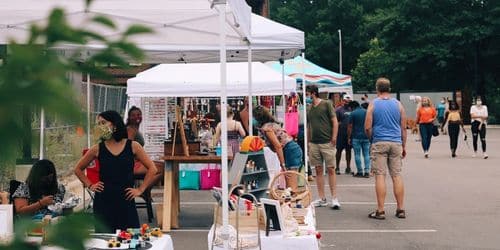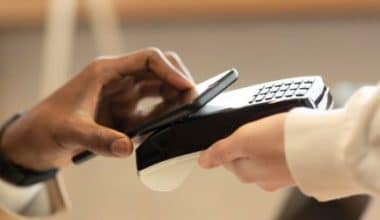As an internet business owner, pop-up shops offer some distinct advantages: they are simple to set up and dismantle, and they do not require you to rent out expensive long-term real estate to set up a regular store.
In this post, we’ll look at how a pop-up shop can help you get started in your small business in 2023. You’ll learn what they are, how to set them up, and see some ideas for a pop-up shop to get you started.
What is a Pop-Up Shop?
A pop-up shop, also known as flash retailing, is a trend in which a business opens a sales location for a limited period before closing it down.
The goal of this strategy is to stimulate attention, create a sense of urgency, and entice people to visit your business for a fun, limited-time event. The pop-ups are frequently themed, include a special giveaway or product, and are completely unique and memorable.
Pop-up shops are using an approach that has long been lacking in marketing: connection. You’re on the front lines communicating with your target audience, which is invaluable in a world where our only connection is through a screen.
How Much Does a Pop-up Store Cost?
The cost of operating a pop-up shop varies depending on its size, duration, and location. While there is no limit to how much you can spend, a short-term pop-up can be set up for as little as $2,000.
It’s worth noting that if you set your shop in a pop-up mall, such as Boxpark Shoreditch, your startup costs will be significantly lower. In other regions, commercial rent would push up the cost. For example, Inkbox, a tattoo business, had to pay $8,000 in rent to acquire a pop-up facility in Toronto’s downtown district. When the world recovers from the epidemic, commercial spaces will likely cost more to rent in the future.
The Advantages of a Pop-Up Shop for Your Company
Pop-up shops are perfect for established businesses wishing to increase their current footprint and customer base. Adding a pop-up shop approach to your sales and branding mix has advantages for any type of business:
#1. Display online products in person.
Pop-up shops that display products in a physical area can be extremely beneficial to online vendors. This is known as “experiential marketing,” which translates to “experience it before you buy it.” This proverb still holds true in our e-commerce-driven society, thanks to the popularity of pop-up shops for e-commerce firms.
#2. Increase your store footprint.
Similarly, established merchants can set up pop-up shops in new locations to explore possible market areas, increase foot traffic to their main store, and raise awareness of online choices in outlying areas.
#3. Bring your products to the globe.
Pop-up shops are also a great forum for artisans and independent manufacturers. Pop-up venues in malls, city centers, and commercial areas present unique products to a large market of potential clients. Their relationships with local stores can also be profitable. Together with in-store sales, they can provide new wholesale prospects if host stores recognize profit potential in the line.
Best Pop-Up Shop Ideas
Now that you understand how pop-up shops function and which areas to target, it’s time to start thinking about pop-up shop concepts. Here are nine popular pop-up shop themes that you can use, and keep in mind that you can include numerous concepts into your continuous pop-up shop business strategy.
#1. Shops Featuring Local Artists
Are you or do you know any local artisans? Locally sourced goods and artisan works are quite popular. Consider pop-up shops in stores that align with your brand if you create a specialty line and find success on marketplaces such as Etsy. Better better, establish an artisan cooperative to stock pop-up shops with a diverse range of local goods. The notion of the artisan collective works effectively in local malls and city centers, particularly during the holiday shopping season.
#2. Shops with Local Flavor
Pop-up shops selling local specialty delicacies are guaranteed to appeal to all shoppers. Make a tasting station the focal point of your pop-up shop if the location and items allow for it. Complimentary tastings typically draw a crowd, and one laden with the region’s distinctive flavors is guaranteed to be memorable.
#3. Holiday Shops
Christmas pop-up shops are usually popular, with themed collections such as eco-friendly decor, holiday pet goods, gourmet holiday cuisine, and while-you-wait services. Personalized presents may set your pop-up shop unique from the competition. With the correct merchandising and a few prepackaged gift packages, every pop-up shop idea on this list may be customized to a Christmas theme.
#4. Local Celebrity Shops
Are you a local superstar, such as a chef, golf pro, designer, or e-book author—or do you want to be? Cleverly branded celebrity pop-up shops are an excellent way to launch your career. Pop-up shops allow you to share your creations and services with the world while also solidifying your public identity.
Generate social media buzz by giving away something related to what you do, such as a free audible download if you’re an author, on-site tastings if you’re a chef, or swing analyses if you’re a pro golfer. Stock shop shelves with products that compliment your brand to increase sales—and don’t forget to alert the press about your limited-time involvement.
#5. Shops Offering Personalized Goods
Personalized products are popular, and pop-up shops are an excellent outlet for items such as personalized clothing, embroidered items, and laser-cut decor. Due to production equipment and time constraints, some bespoke items necessitate the display of samples and the taking of orders. But, things that can be customized while you wait, such as T-shirts and totes, are guaranteed winners for bulk sales, especially at holiday shops.
#6. Shops That Raise Money for Nonprofits
Pop-up shops are ideal fundraising outlets for nonprofits as well as area schools, churches, and social organizations. If you’re on the fundraising committee for one of these groups, you can use the pop-up shop model to sell and collect donations. Consider forming a pop-up shop management group if you’re looking into for-profit pop-up shop concepts with a social purpose. You can contact sites and plan and stage charity pop-up shops for a price.
#7. Shops with Seasonal Essentials
Pop-up shops loaded with trending seasonal items can draw attention, especially when concentrated on a specific seasonal theme. Eco-friendly spring gardening, summer skin care, and football tailgating essentials can set your shop apart from the seasonal competition. Seasonal pop-ups are also a wonderful pitch for local independent retailers that may not invest in a broad assortment of seasonal sellers.
#8. Freebie and Demo Shops
Are you an online influencer, do you manage an affiliate marketing website, or do you write a frugal blog? Pop-up shops can present your internet brand to brick-and-mortar main street shoppers at little costs. Tap your featured brands for free samples, goods for demo stations, and a special manufacturer’s discount. Include your affiliate buy link on coupon handouts to earn a commission on all transactions. Utilize the pop-up shop to display demos and give away freebies. This technique also works well with quick-response (QR) codes for immediate internet purchases.
#9. Vending Machines
Branded vending machines are trendy and provide long-term sales potential with minimal maintenance. Vending machines are excellent for selling beverages and specialized snacks, but that’s not all they can do. Vending machines can be used to deliver personal care products, cosmetics, literature, toys, and pet supplies. Use local vending machine businesses to test-market your line in their machines or manage branded machines for you. You may also buy and personalize machines, lease sites, and manage your own collections and refills.
Important Tools for Pop-Up Shops
The finest pop-up shops are self-sufficient, with no need for host venues to manage sales and payments. They also cross-market their online store and physical retail locations, as well as leverage social media to generate buzz and attract additional customers. With the correct processes and tools in place, incorporating all of this into your pop-up shop concept is simple.
#1. Mobile POS payment system
Mobile payment processors provide a set of solutions for mobile sales management, payment processing, and business tracking. The most popular choice among pop-up vendors is Square, as seen above, although Shopify is a close second if you want to focus significantly on e-commerce sales.
#2. Internet shop
Pop-up shops are an excellent promotion tool for your online store, and they provide customers with a handy location to purchase things in between your pop-up appearances. Again, Square and Shopify are two top-rated systems that easily connect your online, in-store, and mobile pop-up shop sales.
#3. Social media promotion
Using social media postings, videos, stories, and ads generate buzz and enthusiasm for present and forthcoming pop-up shops. Posts that tease shop items and offers are great, but contests, limited-time bargains, and flash giveaways are the real social media gold for pop-up shops. These strategies almost guarantee traffic.
4 Simple Steps for Opening a Pop-Up Shop
- Choose a venue for your event.
- Choose a place for your pop-up.
- Determine the shop type, exterior, and interior.
- Reserve your pop-up shop location.
#1. Choose the location of your event.
Finding the ideal location for your pop-up is crucial. There are a number of aspects to consider, and one of the most crucial is selecting what sort of venue makes the most sense for your event. Pop-up shops are frequently held in the following locations:
- Empty storefront: An empty storefront is a retail location that is only ready to be utilized. All you have to do is tailor it to your brand. Search for unoccupied storefronts in your desired location or get assistance from a local real estate professional.
- Shopping center or mall: Many shopping malls rent kiosks, booth space, or unoccupied in-line stores. Mall space may be less expensive than other locations, but it may place you in front of the best kind of foot traffic—consumers looking to spend their money.
- Pop-ins: These are businesses within stores that are a terrific way to capitalize on the success of an established brick-and-mortar brand. Pop -in@Nordstrom, for example, is a series of pop-in shop collaborations with other businesses, such as Away baggage. Hotels are also fantastic places for drop-ins.
- Gallery/event space: Unlike pop-up shops, gallery or event spaces provide a blank canvas for turning your digital brand into a real venue with eye-catching displays. Unlike some traditional brick-and-mortar retail spaces, these facilities are also prepped and ready for events.
- Mobile: If you don’t want to be confined to a single place, try becoming mobile and renting a truck or bus to host your own traveling pop-up shop. Casper’s Nap Tour traveled from Vancouver to Toronto in 2017, giving customers across Canada the opportunity to try out its mattresses. This allows you to operate in multiple locations and maximize your reach—you may set up in a farmer’s market, park, or any other public venue you believe your clients will frequent.
#2. Choose a place for your pop-up shop.
After you’ve decided on the type of pop-up, you may start thinking about placement. Understanding what your shop’s aims are is a vital consideration.
If you want to debut a new swimsuit collection, consider going somewhere tropical or near a beach. If you’re considering a permanent move into physical retail, utilizing current sales data (if you have it) to determine where the majority of your existing clients reside.
Once you’ve determined a geographical area, consider some additional considerations to assist you to narrow down a precise location.
Some significant factors to consider include nearby stores and events. Check to see if nearby retail stores are complementary or competitive to what you’re offering. Complimentary is wonderful, but you should avoid direct competition.
Related: TRADE SHOW: Explained+[Free Tips] & What You Should Know
When established shops feel threatened by competing stores, you miss out on a potential ally. Take the time to introduce yourself and build relationships with other shop owners in the area. You can learn a lot about what makes your shared target demographic tick from them.
Ultimately, one of the most important factors has always been foot traffic. Is the neighborhood or street you’re thinking about moving to a busy one? Is there a lot of traffic passing by the area you’re looking at—and, more crucially, are those people your target customers?
Nonetheless, some firms may not prioritize buzzy downtown destinations. Following the pandemic, brands began to appear in local areas and suburbs. According to Appear Here data, the five hottest pop-up sites in London are Westbourne Grove, Neal Street, Curtain Road, Columbia Road, and Golborne Road, while the top five in Paris are rue de Turenne, rue Pierre Lescot, rue du Roi de Sicile, rue de Charonne, and rue Debelleyme.
Yet, other firms are remaining in cities and changing their offerings to meet a more cautious consumer mentality. It all boils down to who your consumers are, where they are, and how they want you to appear.
#3. Determine the shop type, exterior, and interior.
Here are a few more considerations to assist you to limit your venue choices:
Pop-up shop type
First and foremost, you must determine the type of event you are hosting and comprehend what makes it appealing to a pop-up shop. Pop-ups come in a variety of forms, including:
- Press preview: Often, this is an invitation-only/exclusive glimpse at your shop for local media and bloggers who can help you spread the news about your store.
- Launch event: Whether it’s your first pop-up shop or the opening of a new product line, pop-up shops make excellent launch parties. Remember, if you’re billing it as a party, you must keep your word. To expand your reach, consider hiring a DJ, serving food and beverages, and encouraging social sharing.
- Experiential: Inspire guests with one-of-a-kind immersive experiences. Consider what types of featured workshops, presenters, and persons are most appropriate for your brand. For example, HutchLA once ran a pop-up shop with a tattoo artist on site since it fit with the brand.
- Influencer gathering: Allow an influencer in your niche to host, curate, and be the “star” of the night to tap into their audience. Encourage them to create anticipation for the event by posting about it on social media, and regard the chance as a cooperation that will pay off handsomely for both parties. They’re given a one-of-a-kind opportunity to meet and greet their fan following—and their fan base becomes your consumer base.
- Sponsored Event: While a single piece of media coverage can be beneficial, investing in a sponsored event can result in even more attention. For example, collaborating with a local publication in your field can provide you with rage before, during, and after your pop-up event.
External variables
- Frontage: Is there a sidewalk in front of the store for walk-ins and foot traffic? Is the frontage large enough to accommodate curbside pickup orders? In the next months, these will be critical concerns for pop-up venues.
- Signage: Look to discover if the shop location you’re interested in comes with signage and, if so, whether you can personalize it. Certain properties may already have branded entry or storefront signs, which may prevent customers from recognizing your shop. Some areas might not permit any signage at all. Decide what you require and how customers will locate your pop-up.
- Condition and cleanliness: While landlords normally guarantee that the interior of a pop-up shop is spotless, the exterior can be vulnerable to the elements. You’ll almost certainly be held accountable for its cleanliness. Bring a broom, your own potted plants, or a bottle of Windex to remove every last face smudge off the venue’s glass.
- Parking and public transportation: The easier it is for visitors to visit your store, the more customers you will have. An on-site parking lot is preferable, but it is not always possible. Therefore make accessibility a priority in whatever manner you can. Investigate public transportation routes, parking meter rates and times, and neighboring paid parking facilities.
Interior elements
- Square footage for browsing: Even as businesses reopen and the pandemic subsides, shoppers’ health and safety will remain key priorities. Make sure the area is large enough to allow shoppers to browse while remaining at a safe distance.
- Internet Access: Wi-Fi is typically included with most spaces, but double-check with the leasing agent to ensure a high-speed internet connection is available. This is essential not just for the smooth operation of your point-of-sale software, but also for your customers to be able to browse your online sales channels while visiting your physical store. It also means that you may arm your sales staff with a mobile POS to quickly pull up customer information and customize the in-store experience.
- Stock space: Visible merchandise that is not on the show can make even the largest areas appear cluttered, so have a storage area. Many areas will lack a back stockroom, so consider utilizing curtains or a room divider to create a makeshift barrier or wall. This will make the room appear more professional and tidy.
- Lighting: Appropriate lighting sets the tone and draws attention to your merchandise. The best lighting for your store is ultimately determined by the vibe you wish to set. Brighter lighting might be appropriate if your brand is more contemporary. Gentle lighting complements brands with a timeless aesthetic. Check to discover if the bulbs are dimmable or if lamps and portable illumination are available as alternatives.
Related: FLASH SALE: Definitive Guide
- Anti-theft features: According to Tyco Retail Solutions, stealing and criminality account for 34% of retail shrinkage. Locate a location with suitable loss protection procedures. Both surveillance cameras and alarm systems are effective instruments for combating shoplifting. If a store area lacks cameras, look to see what alternative strategies prior pop-up entrepreneurs used.
- Display area: Every venue is unique, so make sure the location you’re considering has everything you need to display your items or materials.
- Speaker System: Music is essential for creating a positive atmosphere in your store. If the facility has a speaker system, that’s a huge plus. If not, bring your own Bluetooth speakers and conduct a sound test before you start.
Where Should You Book Your Pop-up Shop Location?
You can inquire directly with realtors to see if they have any pop-up shop venues. There are also numerous internet databases where you may look for properties to book yourself. Here are a few we suggest:
- We Are Pop Up
- Neyborly
- Appear Here
- Bulletin
- Pop Up Shops
- Uppercase
- Poppir
- Storefront
- Peerspace
- Popertee (UK)
Tips for Securing Your Pop-up Shop Location
When procuring a space, pop-up entrepreneurs should be conversant with the following legal documents:
#1. Lease
The lease is the most crucial document. Under a lease, the renter has deemed a tenant and is granted exclusive possession for the time agreed upon by both parties, sometimes known as the “term” of the lease. The term will specify what you are permitted to do in the space, such as modifications, hours of operation, and other important factors.
Get a detailed estimate of your monthly payment when evaluating a shop location. Depending on your space, additional charges could equal basic rent, doubling your monthly payment amount. If you weren’t prepared to pay for it, this may crush your finances.
#2. Licenses
Depending on your location and the length of your pop-up shop, you may require a license rather than a short-term lease. A license grants you, the licensee, the legal right to use the landlord’s asset. In some circumstances, using the property without a license is illegal.
Licenses are typically issued for short-term occupiers and come with a restricted agreement that does not always guarantee exclusive use of the property.
#3. Permits
Each location has its own set of legal rules and standards for company permits. Many localities, for example, demand a permit to sell food and beverages. Hence, if you intend to serve champagne at your opening, you must obtain the necessary license.
Check with your real estate agent, landlord, and/or the city to be sure you’re completing all required by local law before opening day.
#4. Insurance
Personal insurance is not the same as business insurance (or commercial insurance). Without the necessary insurance plans in place, you are placing not just your business at risk, but also your staff and customers.
Some rentals include insurance, but you should consult a risk management specialist or agency.
Things to ask before booking a spot
Prepare the following questions for your property manager or real estate agent to ensure you fully understand what you’re getting into:
- What is the rental price? Determine the daily, weekly, or monthly rate (depending on how long you plan to be open). Make sure to check out various spaces and assess your options, and don’t be hesitant to bargain on pricing before signing.
- What is included in the rental price? Examine what you’re getting for your money. Take careful note of details such as square footage, amenities, and occupancy dates—and get everything in writing.
- Are there any additional utility costs? Explain any additional expenditures and how they will be distributed. Make sure you understand which expenses are your responsibility—and whether they are acceptable. A pop-up rental’s utility expenditures can quickly add up.
- What is the room’s layout? Get a strong understanding of the shop’s current layout so you can imagine the final presentation. To ensure that the room will meet your demands, it may be helpful to create a scale drawing.
- What are the exact measurements of the ceiling, windows, doors, countertops, pillars, and so on? Know exactly what you have to work with—and around. This information is useful when creating displays or printing signage because it will give you an idea of how much or how little you’ll need to dress up the space.
Related: OPEN STORE: What Is It & All You Should Know
- Can the space be changed? Determine how much power you have over the environment. If you share a gallery with numerous vendors, you may not be allowed to drill holes in the wall or make significant adjustments. Identify the landlord’s dos and don’ts, as well as whether they will work with you.
- Who is responsible for what? Property owners will usually want to restrict their responsibilities, so check the fine print on your lease carefully. If something bad happens, such as a fire or a plumbing problem, it’s best to know who’s to blame right away rather than later arguing or filing a claim.
- Is there Wi-Fi or internet access? To process transactions and take credit card payments with your POS system, you’ll need an internet connection, so find out if it’s included or if you’ll have to set it up yourself.
- Will I require insurance? Obtaining property insurance is frequently required when signing a lease agreement. This type of coverage protects you from a variety of potential problems, including, but not limited to, theft, venue or glass repairs, and merchandise damage.
- How much of a deposit is necessary to secure the venue? If your pop-up shop will be open for several months, the rental deposit is usually equal to one month’s rent. For shorter leases, you may be required to put down one-third of the total rent payment. Make sure you understand how and when you will receive your deposit back after the pop-up has expired.
- What kind of foot traffic should I anticipate? It’s a good idea to conduct your own foot traffic research, but the property owner may have numbers they can share with you. This is especially important if you’re renting a booth at a trade show.
Conclusion
In summary, pop-up stores are temporary establishments that use unique customer-targeting tactics. By temporarily occupying a retail location, these businesses advertise products or services. Pop-up stores are inexpensive and give businesses visibility and new clients.
- The 19+ Best POINT OF SALE SYSTEMS FOR SMALL BUSINESS in 2023 (Updated)
- HOW DOES A CONSIGNMENT SHOP WORK?
- RETAIL STORE: Difference, How to Start and Run It
- WHAT IS A CONSIGNMENT STORE? Best Online Consignment Stores In 2023
- HOW TO START A COFFEE SHOP IN 2023: Ultimate Guide






